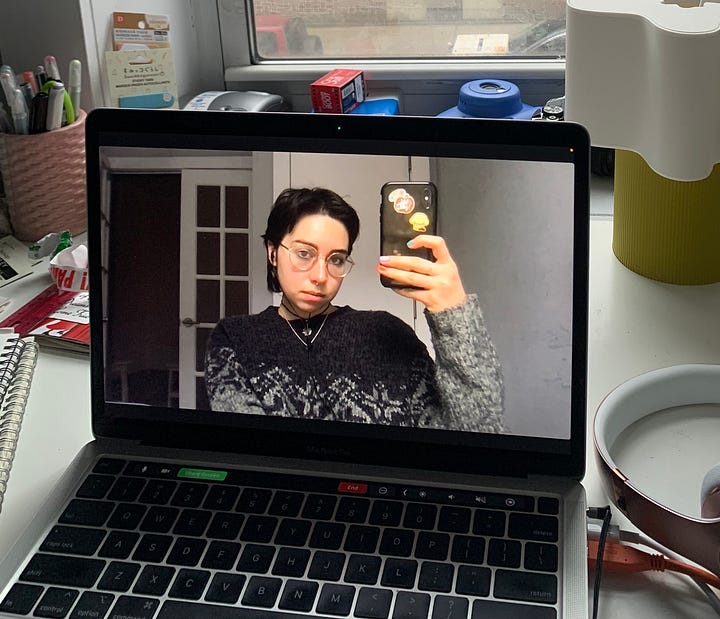There's a passage from Infinite Jest that I think about everyday. Granted, there's a lot of Infinite Jest that I think about everyday, but this section in particular resonates with the basest of my frequencies. Set in the near future from its release in 1996, the novel examines with shocking prescience the likely mutations of the media and technology familiar to the reader at time of publication. Its author, David Foster Wallace, doesn't explore technology's total encroachment into each and every one of our routines the way of science fiction, but rather extrapolates his anxieties about the addictiveness of television into a familiar dystopia. In the passage of interest, he retraces the evolution of phone calls into video calls, which eventually become defunct. Wallace is by no means the first to imagine the leap from audio to video communication, but perhaps the first to consider the latter's demise. In Infinite Jest, video calling illuminates the great paradox of voice calling: talking on the phone allows you to carry on conversations while absorbed in other tasks, while maintaining the illusion that the person on the other end of the line is solely focused on your conversation1. Video calling shatters this illusion and turns simultaneous, long distance communication into a performance. People become so obsessed with their own appearance that they begin purchasing life-like masks and cutouts2 to use during video calls. This fixation on appearances becomes overwhelming at a society-wide scale; voice calling resumes its primacy.3 Wallace foretells the current landscape of video calling with devastating accuracy, predicting that the technological feat of seeing someone while talking to them from thousands of miles away is irrelevant, because we're all too busy looking at ourselves to care.
I first became aware of how much I look at myself on Zoom when my boss complained after a meeting that her colleague was obviously looking at herself in the self-view window and fixing her hair constantly. Oh my god, I thought. Do I do that too? From then on, I systematically turned off self-view and started noticing other people's preening. Truthfully, I'm not so much bothered as I am fascinated by it.


Jacques Lacan, originator of the mirror stage in psychoanalysis, would probably have a lot to say about this phenomenon. According to his theory, there is a moment in infancy when we begin to recognize our shape in a mirror as just that, our own. The University of Hawaii's page on the subject explains: "the image of a unified body does not correspond with the underdeveloped infant's physical vulnerability and weakness, this imago is established as an Ideal-I toward which the subject will perpetually strive throughout his or her life." The mirror image is a referent which contrasts how we think we look with how objectively we look. But as anyone who has taken selfies on Instagram instead of their camera app to avoid seeing their image flipped horizontally knows, not all mirrors are created equal.
Last week, Meta, Facebook and Instagram's parent company, was sued by 33 states, led by California and Colorado, for implementing attention-holding features in its apps that cause harm to children4. The pay-walled NYT article cites "infinite scroll" and "persistent alerts" as prominent app features under fire that drive people, especially those whose brains aren't done cooking, to open and stay on these apps for long periods. I would add "face filters" to this list, culprits not because they hide what we look like, but because they make us look "better." "Better," in quotes, because it's not really better, is it?5 I've recoiled in horror at photos of my favorite people distorted with swollen lips or with their Caucasian eyes slanted in a way reminiscent of yellowface.
Aesthetics of beauty aside, people continue to use these filters because they like the way they look, so much so that Instagram has implemented this feature in their app-supported video calls. FaceTime has followed suit, as has Zoom with its "touch up my appearance" setting. In Infinite Jest, Wallace doesn't entertain the idea that the masks might be intended to benefit the user's conversation partner. They're an egotistical purchase denoting an obsession with one's own appearance. I find that this extends to the real technological counterparts to his fictitious masks. No one applies the "touch up my appearance" filter out of aesthetic sympathy for the other caller. It exists to feed our vanity, and keep us online longer.



I'm distressed by how one of our primary tools for communication, for interpersonal connection, is distorted into a site for self-obsession to support the interests of tech companies. Long distance communication is already laden with imperfections. From wireless connectivity issues to scheduling across time zones, it is hard to maintain friendships with those far away. The glinting view of one's self in the frame poses an additional impediment to that difficult dance. And even when we look at ourselves, it's not ourselves we are seeing, but a version curated to satisfy our own vanity. Filters aside, finding the perfect angle where a shadow obscures the fleshy part of your jaw or where the bald spot near your temple is out of frame constructs its own illusion. A better example of this is not wearing pants on a video call. We disavow what is outside of the frame and create a false reality for the other caller6. There's a glint of filmmaking at play, of mise en scène to construct the perfect image.
And how could I be annoyed at a relative of cinema? Or deny the raw utility of a self-view window? Of course we need to be able to make sure nothing unsightly is in our background on work calls and adjust the camera angle to ensure we're fully visible. Beyond this cadrage though, do we need to see ourselves? A quick pass in front of a mirror can accommodate necessary, last minute fixes in our appearance. I've sat with this idea for a while now, and I can't come up with a definitive reason for why we Need to be able to see ourselves through the full duration of a video call.
The camera component complicates everything immensely for me on another level. It conditions us to police our own appearance and habituates us to being "on camera." Think of how much more sinister the cameras at Target's self-checkout stations would be if they didn't reflect your pixelated face back to you. In forcing us to remain mindful of how we look, self-view or front-facing cameras in general compel us to Behave for the sake of an unseen watcher. As cameras proliferate, performance overtakes natural behavior. We are not ourselves in this mediated environment. I think there's something lost there, or something of lesser value than what it supersedes being created. That something lost is an intimacy of sorts, the difference between a candid photo and a staged one. Extend this difference from a photo to a conversation and you'll start to understand the loss I'm getting at.
An article by Russell Brandom published in The Verge about four years ago argues that Wallace was wrong7 about video-calling, that his predictions are rendered essentially moot by the existence of texting which overtook voice-calling before Skype and FaceTime became prevalent due to its achievement of immediacy. I strongly disagree with his opinions on the potency of Wallace's ideas, especially today when the COVID pandemic has pulled video calling to the forefront of our long distance communications arsenal. We love looking at ourselves. The mechanics and technology of video calling allow us to like the version of ourselves we see, making us all the more prone to shifting our gaze to the upper right of our video call window. Media companies have preyed upon the very human desire to look at ourselves and created addictive products that fray our social fabric by replacing interactions with performances.
David Foster Wallace was obsessed with and horrified by visual media's potential to become a life-consuming force. The titular Infinite Jest is a movie revealing the face of the PGOAT (Prettiest Girl Of All Time)8, resulting in a film so good its watchers inevitably die because they can't bring themselves to look away from it. Who is to say the real PGOAT isn't the girl reading this and Infinite Jest isn't the movie unfolding in the top right of her screen?
talk soon. annalise9
article focus aside, this is the most insightful part of the passage to me, and an excellent example of Wallace's grasp of social ills.
imagine those standees that you stick your face into… ykwim
i really recommend reading this passage, weirdly available on this kickstarter page
this lawsuit is Fascinating. it's being argued as a consumer protection case, but specifically wrt children, which i feel suggests adults are not susceptible to the same harmful effects.
check out jia tolentino's essay on Instagram Face
you do not want to get me started on people who buy RING LIGHTS for their office set up
i feel seen in that he too took time out of his day to write about a passage of Infinite Jest no one else cares about; in this sense, we are bretheren and i stand united with him. but his articles takes jabs at Wallace's writing that i simply won't stand for. he's allowed to capitalize long sections if he wants to!!!
this acronym changed my life
i realized while revising this publication that there's a gendered level to this issue that i didn't articulate but i hope the ideas resonate with everyone to some degree.




“talking on the phone allows you to carry on conversations while absorbed in other tasks, while maintaining the illusion that the person on the other end of the line is solely focused on your conversation” - this is too good. There’s such an intimacy to phone calls, the illusion you’re alone in the world with another person that video can’t capture.